Japanese Dishes: 10 Famous Foods You Have to Try

When you go to Japan, be sure to eat these 10 traditional Japanese dishes. In this article, find out what to dine on to enjoy Japan's rich washoku food culture fully, from sushi to miso soup, unagi eel, tempura, soba, udon, and rice balls.
Traditional Japanese Food - The Must-Try Dishes!
When visiting Japan, you'll, of course, want to taste Japanese cuisine.
There are many types of dishes and local specialties you can choose from, but if we were to pick up ten traditional dishes that we highly recommend, they would be the ones introduced below.
Top 10 Traditional Japanese Dishes
1. Sushi
2. Sashimi
3. Unagi - Grilled Eel
4. Tempura
5. Soba (Buckwheat Noodles) and Udon (Wheat Noodles)
6. Onigiri - Rice Balls
7. Yakitori - Grilled Chicken Skewers
8. Sukiyaki
9. Oden - Simmered Ingredients
10. Miso Soup
1. Sushi

Photo by Pixta
Sushi is one of the best known Japanese foods around the world. It is offered in various ways and prices, from the entertaining kaiten-zushi (conveyor belt sushi), where visitors can enjoy sushi for a reasonable price of about 100 yen per plate, to high-end, long-established, traditional Edomae sushi (Edo-style sushi) where you will sit at a quiet counter to eat as the sushi is prepared right before your eyes.

Sushi usually refers to a dish of pressed vinegared rice with a piece of raw fish or shellfish, called a neta, on top. Sushi is generally eaten with soy sauce and wasabi, but those who aren't too fond of wasabi can ask for "sabi-nuki" (meaning "without wasabi").
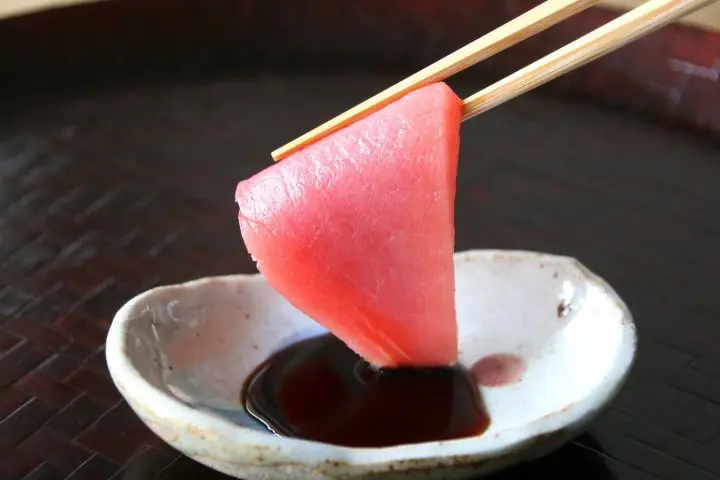
Photo by Pixta
Sushi can be eaten with chopsticks or directly with your hand. However, there's one thing you should be careful about. When dipping the sushi in soy sauce, you should turn it over and apply the soy sauce to the neta, rather than the rice itself. This is to prevent the rice from sucking up too much soy sauce and erasing the original taste of the "neta" itself.
Read also
2. Sashimi
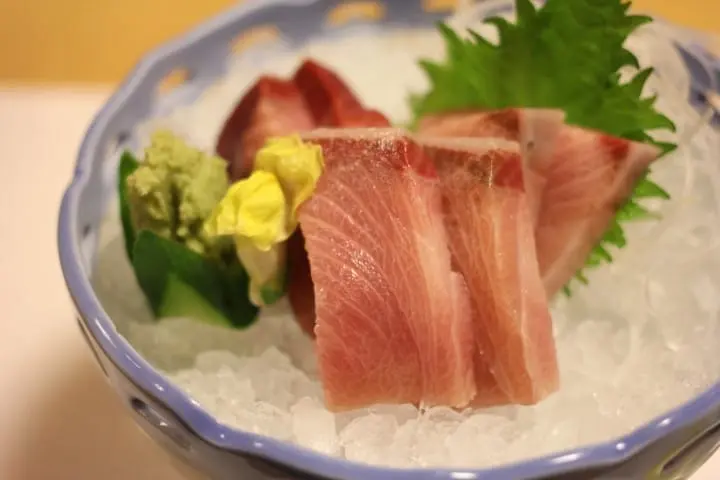
Sashimi is another must-try food. Similar to sushi but without the rice, sashimi is raw fish sliced into easy-to-eat pieces. The high quality of the fish caught in all regions of Japan makes it a great choice no matter if you are visiting Tokyo, Kyoto, or anywhere else.
Just like sushi, diners can enjoy dozens of varieties of sashimi. Some of the most common and popular varieties are maguro and other tuna varieties, salmon, mackerel, and sea bream. You can also try clams, uni, or sea urchin, and salmon roe. Find out what fish and seafood you like the best by ordering a variety.
Sashimi is typically eaten with soy sauce for flavoring. You can also add a dot of wasabi to the top of the sashimi for extra heat, but it is not required. Certain varieties, like horse mackerel, will be served with ginger instead of wasabi.
↑ Return to the top of article.
3. Unagi - Grilled Eel

Unagi, or eel, is a fish known to be found mainly in rivers. In Japan, it is a delicacy typical in high-class Japanese dining. There are also many casual restaurants that specialize in unagi dishes. At unagi restaurants, you will be able to enjoy kabayaki, where the unagi is put on skewers and grilled with a special sauce containing soy sauce, mirin, sugar, and sake. Unadon, a dish of kabayaki on top of white rice, is also offered at these establishments.

Hitsumabushi, a specialty dish from Nagoya, is another must-try traditional dish. Its appearance may surprise people––cut-up kabayaki on top of white rice––but it can be eaten in several ways, such as with condiments like green onion and wasabi, or as ochazuke by pouring warm green tea or broth over it. Unagi is also loved as a health food to prevent summer heat weariness for its protein and because it is good for digestion.
4. Tempura
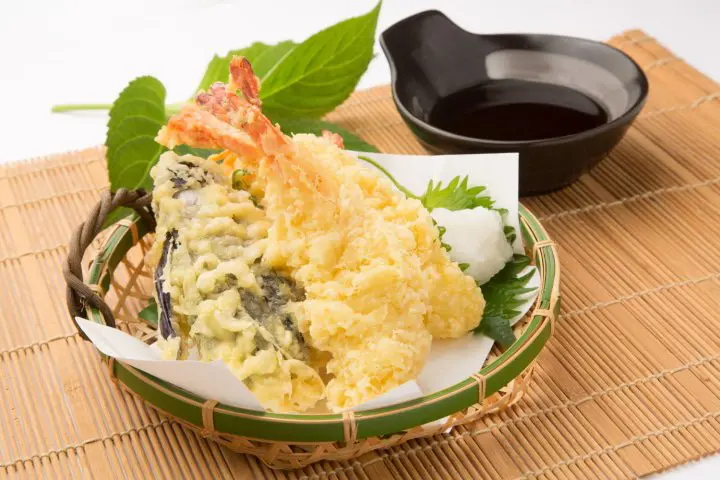
Photo by Pixta
Tempura is a dish involving ingredients like seafood, meat, and vegetables covered in batter and deep-fried in oil. The batter usually contains flour and egg. Tempura is generally dipped in a special sauce called tentsuyu before eating. Tentsuyu is a sauce made of broth from kombu or dried bonito, mirin, and soy sauce mixed at a ratio of 4:1:1 and cooked. You can add ginger or grated radish to your liking for a more refreshing taste.
Read also
↑ Return to the top of article.
5. Soba (Buckwheat Noodles) and Udon (Wheat Noodles)
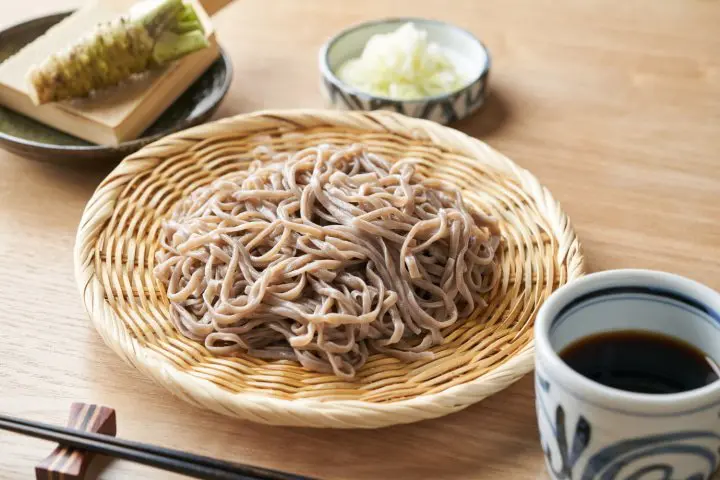
Photo by Pixta
Soba is a noodle dish made from buckwheat flour with water and flour, thinly spread and cut into noodles with widths of 1cm-2cm. After boiling the noodles in hot water, it is eaten dipped in cold soup, or by pouring hot soup over it. The soba broth (tsuyu) is typically made from kombu or dried bonito broth, seasoned with soy sauce and mirin, and is crucial for having a delicious soba experience.
Soba is enjoyed hot or cold, making it an ideal dish year-round.

Udon is a unique dish known for its thick noodles, and is a very popular and traditional Japanese dish. The dough is made from flour and salt water that is well-kneaded and cut into noodles. After udon noodles are boiled in hot water, udon is enjoyed in seafood broth soup, or by pouring soup and toppings like tempura on top of it. Like soba, you can savor udon hot or cold. There is no one designated way to eat udon.
Read also
6. Onigiri - Rice Balls
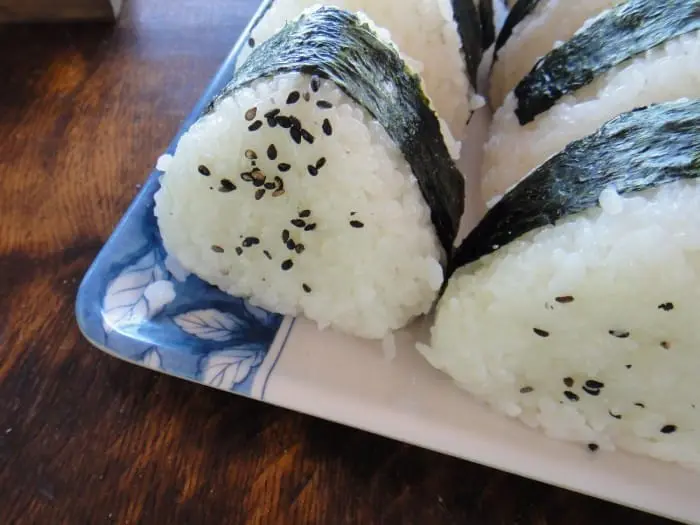
You may have heard of onigiri, or rice balls, before. Onigiri, also called omusubi, may just look like plain rice, but they often have a savory filling inside and are wrapped with a salty sheet of nori seaweed. They are made in bento lunches by families and often seen sold in convenience stores and supermarkets. This is a classic choice for a snack or light meal.
Common flavors for onigiri include kelp, pickled plum (umeboshi), salmon, and bonito flakes. There are also many other flavors--go into a convenience store or supermarket to see what you can find.
Although you can make onigiri yourself and buy it inexpensively, there are restaurants offering onigiri you can enjoy at a sit-down meal, made by hand by chefs with high-quality ingredients. Onigiri Asakusa Yadoroku in Tokyo is one restaurant that has received a Michelin star for its exquisite rice balls.
Read also
↑ Return to the top of article.
7. Yakitori - Grilled Chicken Skewers
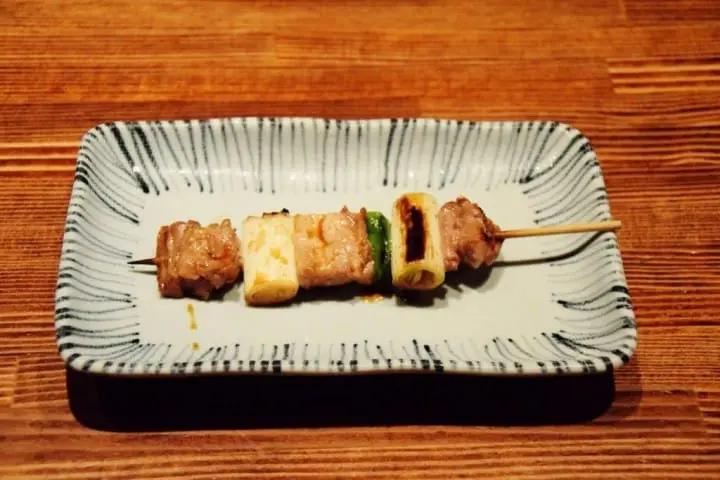
Yakitori is a popular food where chicken is cut into small pieces, then placed on bamboo skewers and grilled. It is often found on the menus of izakaya and casual restaurants, making it a good option for a night out in Japan with friends. It is especially delicious when paired with alcohol. Also, if you go to a Japanese festival, there is a good chance that food stalls will be selling this classic dish.
Yakitori is ordered at restaurants by the part of the chicken. You will also find other types of meat and vegetables on skewers, too. It is usually seasoned lightly with salt when it comes, so take the first bite without adding extra condiments. You can eat right off the skewer.
Read also
8. Sukiyaki

Sukiyaki is cooked in a shallow iron pan, traditionally enjoyed in the fall and winter in Japan. It became popular in Japan around the 19th century. Made both in homes and available on menus at restaurants, it is a dish you will want to try when you're craving something hearty.
Sukiyaki is made with several different ingredients, like thin slices of beef, green onions, tomatoes, mushrooms, and tofu. Diners prepare the dish themselves by grilling the ingredients in the pan after pouring a few drops of sukiyaki sauce. After the ingredients are cooked thoroughly, to eat sukiyaki in its conventional way, you dip the meat or vegetable into a bowl of beaten egg.
The result is a delicious and satisfying dish that goes great with rice and will warm you from the inside out during chilly days.
↑ Return to the top of article.
9. Oden - Simmered Ingredients
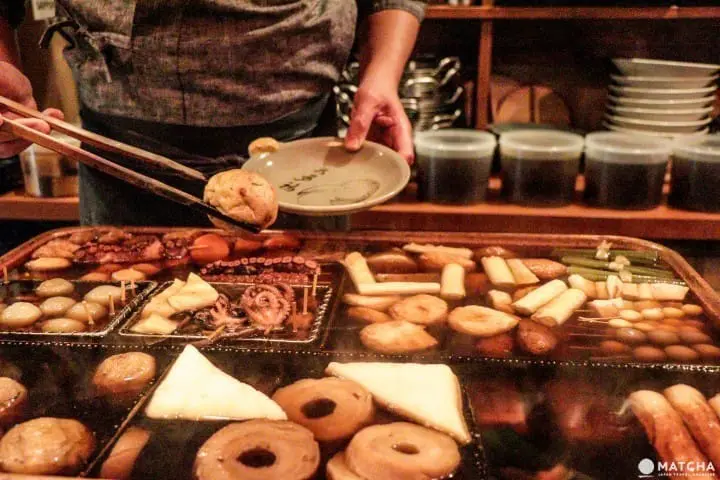
Oden is dish of various ingredients simmered in broth. The ingredients are meant to bring out the flavor of the dashi (consisting usually of a mixture of seafood and kelp) and have a savory, salty taste. Oden has been eaten for a long time in Japan and is thought to have been first made during the Muromachi period (1336 – 1573).
Mild-tasting vegetables, tofu, and fish are common ingredients in oden. Daikon radish, a thick root vegetable, can be found at most shops with oden. Another popular choice is ganmodoki, a hearty mixture of tofu and vegetables made into a circular shape.
Restaurants, food stalls sell oden, and you can even see it at convenience stores in the fall and winter months. In Akihabara, Tokyo, there are even vending machines where you can buy oden in cans. Be sure to try this iconic dish when you are in Japan!
Read also
10. Miso Soup
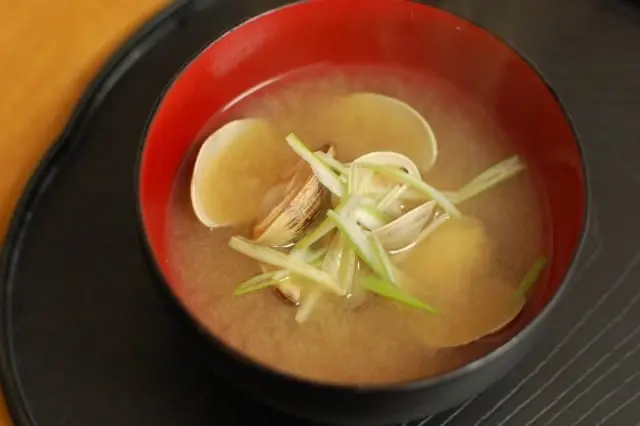
Miso soup is another famous Japanese food, renowned for its great taste and health benefits. This soup is conventionally drunk accompanied by other side and main dishes. A traditional Japanese diet generally includes drinking miso soup daily.
Miso soup is made simply, with the fermented miso base, which has a flavorful taste full of depth, added to Japanese dashi (conventionally mixture of bonito and kelp). There are hundreds of regional varieties on miso soup, from simple soups with just seaweed and tofu to ones with crab and a variety of vegetables.
Miso paste itself comes in different types, from white, which has a sweet flavor, to a darker, saltier red. Be sure to enjoy authentic miso soup when you are in Japan. It is served at most Japanese restaurants in all price ranges; you will find miso soup with teishoku set meals as well as high-end kaiseki cuisine, and everything in between.
↑ Return to the top of article.
Bring Home Japanese Flavors with Cooking Classes

It can be difficult to leave Japan after sampling such delicious and authentic food. For those not near good Japanese food, we recommend honing your cooking skills and learning the recipes for yourself!
airKitchen is a cooking class platform that allows visitors to easily take classes and learn how to make classic dishes, from miso soup to ramen, to soba and sushi.
With locals as hosts, class participants can learn up-close and personal what goes into making the distinct Japanese flavors so delicious. Classes are held throughout Japan, with the most available in Tokyo, Kyoto, Osaka, Hokkaido, and Fukuoka (the link below shows Tokyo availability).
Browse Cooking Classes (Tokyo)
Hosts can provide support in English and, in some cases, other languages. Most teachers will allow modifications for vegetarian, vegan, halal, and gluten-free needs; be sure to input your dietary needs when making a reservation.
FAQ
What are the top 10 Japanese dishes?
Traditional Japanese cuisine offers a delightful tapestry of flavors and cooking styles, with top dishes that have captivated taste buds worldwide. From the elegant simplicity of sushi's vinegared rice paired with fresh fish to the indulgent crispness of tempura's deep-fried delights, Japanese culinary treasures like ramen's comforting noodle soups and the pristine slices of raw seafood known as sashimi tantalize the senses. The savory grilled skewers called yakitori, the tonkatsu crispy pork cutlets, and the customizable okonomiyaki pancakes add layers of texture and taste to the gastronomic experience. Japanese classics like hearty udon noodle bowls, sweet and savory sukiyaki hot pot, and the comforting miso soup round out a top 10 list that reflects the country's culinary mastery and cultural richness.
What are unique cuisine dishes in Japan?
Japanese cuisine is a treasure trove of unique and diverse dishes beyond the well-known classics, showcasing a culinary culture rich in tradition and innovation. From the creamy delicacy of Shirako, fish sperm sacs prized for their texture, to the daring flavors of Fugu, the potentially lethal pufferfish expertly prepared as a delicacy, Japanese gastronomy presents a world of unusual yet delectable experiences. Basashi introduces raw horse meat, while Natto offers fermented soybeans with a strong taste and sticky consistency. Uni delights with its briny sea urchin roe, and Hoya surprises with sea pineapple, a coastal delicacy. Kaiseki cuisine tops it off with a refined multi-course dining experience that highlights seasonal and regional ingredients with precision and artistry. These unique dishes form a captivating tapestry of flavors and textures that demonstrate Japan's culinary diversity and willingness to explore the boundaries of taste.
What is a popular street food in Japan?
One of the most popular and beloved street foods in Japan is Takoyaki. Takoyaki are savory octopus balls made from a batter of wheat flour, dashi (fish stock), and various ingredients like green onions and pickled ginger, all cooked in a special takoyaki pan with hemispherical molds. A piece of tender octopus is typically placed in the center of each ball. Once cooked to perfection, they are topped with takoyaki sauce, mayonnaise, bonito flakes, and seaweed powder, creating a harmonious blend of flavors and textures that delight food enthusiasts across Japan and around the world. Takoyaki stands are a common sight at festivals, street markets, and food stalls, offering a warm and flavorful treat that captures the essence of Japanese street food culture.
What are 3 popular foods in Japan?
Sushi, Ramen, and Tempura stand as three culinary pillars of Japanese cuisine, celebrated worldwide for their distinct flavors and cultural significance. Sushi, featuring vinegared rice and a variety of fresh ingredients, showcases the artistry and precision of Japanese culinary tradition. Ramen, a flavorful noodle soup bathed in rich broths and topped with an array of ingredients, offers comfort and complexity in every steaming bowl. Tempura, with its delicate batter and crispy texture enveloping seafood and vegetables, presents a harmonious balance of flavors and textures that exemplifies Japanese culinary finesse. These dishes epitomize the diverse and captivating nature of Japanese gastronomy, enchanting palates across the globe with their delicious tastes and cultural heritage.
What is Japan's national food?
While Japan doesn't have an official national food, sushi is considered to be the unique cuisine that was born in Japan. Originally a street food popular among the citizens of Edo during the Edo period (1603-1868), sushi has become a highly appraised premium dish. In Japan, sushi is enjoyed on special occasions and at celebrations. On the other hand, if you want to know the dish most frequently eaten by the Japanese, then curry rice comes to mind. Japanese curry rice, known as "kare raisu", is a beloved comfort food that has been embraced by the Japanese palate, becoming a staple in households and restaurants across the country. This dish typically features a thick, slightly sweet curry sauce with vegetables and meat (often beef, pork, or chicken) served over steamed rice. Being easy to make and comforting, curry rice is often enjoyed in Japanese homes, once in one or two weeks. While curry rice is not officially designated as Japan's national food, its widespread popularity and integral role in Japanese cuisine make it a strong contender for a dish that resonates deeply with the Japanese people.
Savor Traditional Japanese Food!
What do you think of our selection? Take the first opportunity to taste these dishes when visiting Japan. Japanese restaurants tend to specialize in one type of cuisine, and we recommend that you try these traditional dishes at specialty stores.
Read also
94年生まれ。神戸出身、東京在住。アメリカからの帰国子女。旅、アート、食が大好きな大学生。
































































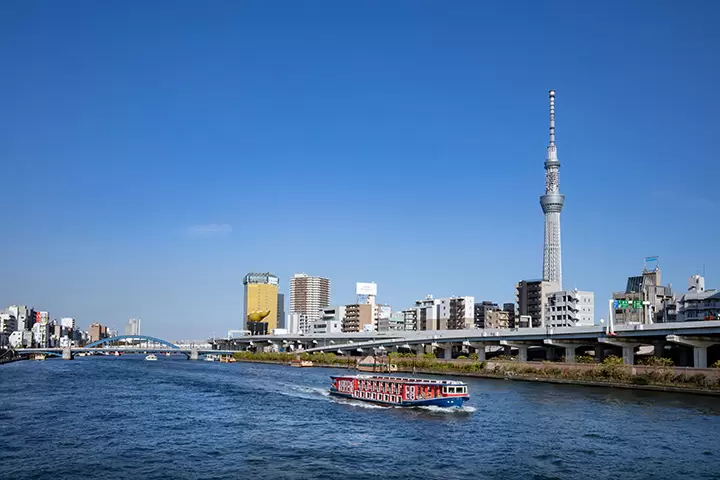


![[Just a short distance from Nagoya] Popular Taiwanese YouTuber Alan tours Aichi, Tokoname!](https://resources.matcha-jp.com/resize/720x2000/2026/01/08-255181.webp)